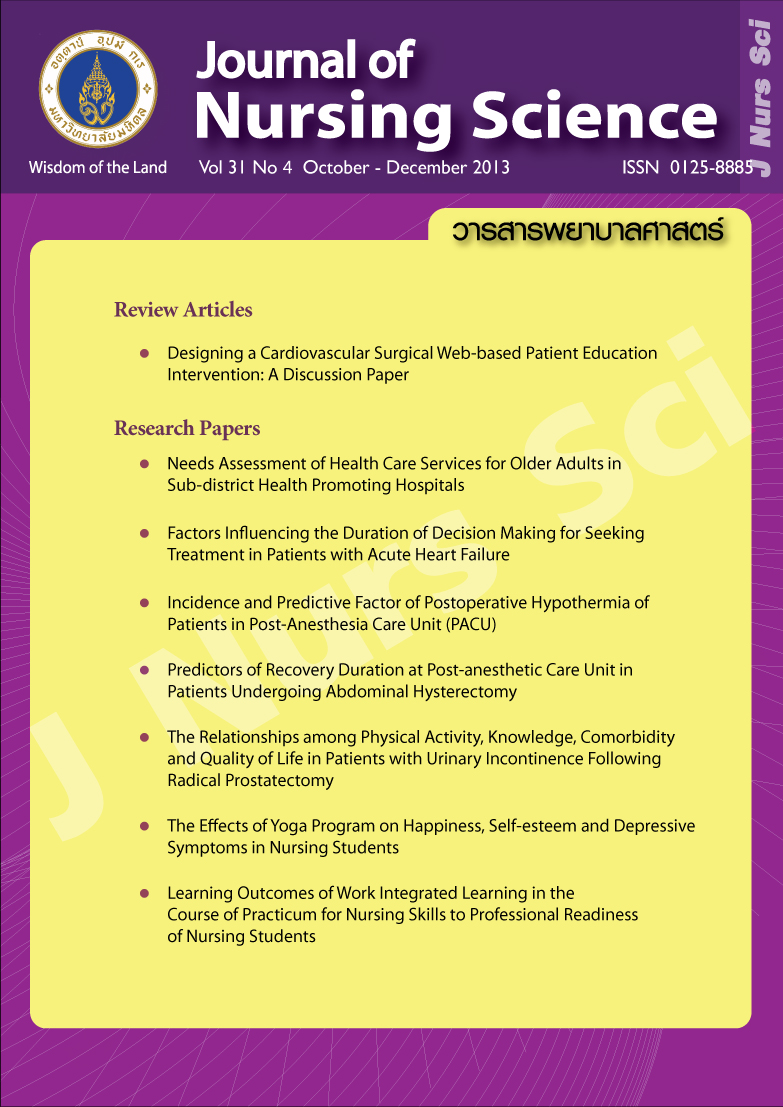The Relationships among Physical Activity, Knowledge, Comorbidity and Quality of Life in Patients with Urinary Incontinence Following Radical Prostatectomy
Main Article Content
Abstract
Purpose: To investigate the relationships among physical activity, knowledge, comorbidity, and quality of life in patients with urinary incontinence following radical prostatectomy.
Design: Descriptive correlational research.
Methods: The study sample consisted of 88 patients with urinary incontinence following radical prostatectomy via laparoscopic radical prostatectomy and robotic-assisted laparoscopic radical prostatectomy, whose postoperative duration was longer than three months. The study period was from February to May, 2013. The data collection instruments comprised demographic characteristic questionnaire, physical activity questionnaire, urinary incontinence knowledge scale, comorbidity scale, and incontinence quality of life questionnaire. The data were analyzed using descriptive statistics and Pearson’s product-moment correlation.
Main findings: The overall quality of life in patients with urinary incontinence following radical prostatectomy was relatively high (X = 88.8, SD = 10.63). The subjects’ levels of energy exertion in physical activities ranged from 52.36 to 293.91 MET hours/week. Fifty-eight percent of the subjects had a moderate level of knowledge about urinary incontinence. More than two-thirds of the subjects (69.3%) had a low level of comorbidities, and the study findings revealed that there was a statistically significant negative relationship between knowledge and quality of life in patients with urinary incontinence following radical prostatectomy (r = - .22, p < .05).
Conclusion and recommendations: Nursing care plans should be devised so as to provide knowledge simultaneously with pelvic floor muscle exercises before the radical prostatectomy, and there should be periodical monitoring and follow-ups. This is because all of these steps are considerably important to enable patients to have a smooth transition to ensure good quality of life when they return home.
ความสัมพันธ์ระหว่างกิจกรรมทางกาย ความรู้ โรคร่วม และคุณภาพชีวิตของผู้ป่วยที่มีภาวะกลั้นปัสสาวะไม่อยู่ ภายหลังผ่าตัดต่อมลูกหมากออกทั้งหมด
อรวรรณ ปรางประสิทธิ์, สุพร ดนัยดุษฎีกุล, อรพรรณ โตสิงห์, ภควัฒน์ ระมาตร์
บทคัดย่อ
วัตถุประสงค์: เพื่อศึกษาความสัมพันธ์ระหว่างกิจกรรมทางกาย ความรู้ โรคร่วม และคุณภาพชีวิตของผู้ป่วยที่มีภาวะกลั้นปัสสาวะไม่อยู่ภายหลังผ่าตัดต่อมลูกหมากออกทั้งหมด
รูปแบบการวิจัย: เป็นการวิจัยเชิงบรรยายความสัมพันธ์
วิธีดำเนินการวิจัย: กลุ่มตัวอย่างเป็นผู้ป่วยที่มีภาวะกลั้นปัสสาวะไม่อยู่ภายหลังผ่าตัดมะเร็งต่อมลูกหมาก 3 เดือนขึ้นไป ที่ผ่าตัดด้วยกล้องและแขนกลหุ่นยนต์ช่วยผ่าตัด 88 ราย ระยะเวลาการศึกษาตั้งแต่เดือนกุมภาพันธ์-พฤษภาคม 2556 เครื่องมือรวบรวมข้อมูลประกอบด้วย 1) แบบบันทึกข้อมูลส่วนบุคคล 2) แบบสอบถามเกี่ยวกับการมีกิจกรรมทางกาย 3) แบบประเมินความรู้ภาวะกลั้นปัสสาวะไม่อยู่ 4) แบบประเมินโรคร่วม 5) แบบประเมินคุณภาพชีวิตผู้ที่มีปัญหาภาวะกลั้นปัสสาวะไม่อยู่ วิเคราะห์ข้อมูลด้วยสถิติพรรณนา และสัมประสิทธิ์สหสัมพันธ์ของเพียร์สัน
ผลการวิจัย: คุณภาพชีวิตโดยรวมของผู้ป่วยที่มีภาวะกลั้นปัสสาวะไม่อยู่ภายหลังผ่าตัดมะเร็งต่อมลูกหมากค่อนข้างสูง (X = 88.8, SD = 10.63) มีระดับการออกกำลังกายที่มีการใช้พลังงานในการมีกิจกรรมทางกายอยู่ระหว่าง 52.36-293.91 หน่วยพลังงานมาตรฐาน ชั่วโมง/สัปดาห์ ร้อยละ 58 มีความรู้เกี่ยวกับภาวะกลั้นปัสสาวะไม่อยู่ในระดับปานกลาง ร้อยละ 69.3 มีระดับความรุนแรงของโรคร่วมในระดับน้อย และพบว่าความรู้มีความสัมพันธ์ทางลบกับคุณภาพชีวิตของผู้ป่วยที่มีภาวะกลั้นปัสสาวะไม่อยู่ภายหลังผ่าตัดต่อมลูกหมากออกทั้งหมดอย่างมีนัยสำคัญทางสถิติ (r = - .22, p < .05)
สรุปและข้อเสนอแนะ: ควรมีการวางแผนการพยาบาลเพื่อให้ความรู้ไปพร้อมกับการฝึกบริหารกล้ามเนื้ออุ้งเชิงกรานก่อนการผ่าตัดมะเร็งต่อมลูกหมาก ตลอดทั้งควรมีการติดตามเป็นระยะ เพราะทุกขั้นตอนมีความสำคัญยิ่งที่จะช่วยให้ผู้ป่วยสามารถเปลี่ยนผ่านไปสู่คุณภาพชีวิตที่ดีเมื่อผู้ป่วยกลับไปอยู่ที่บ้าน
คำสำคัญ: กิจกรรมทางกาย ความรู้ โรคร่วม คุณภาพชีวิต
Article Details
Copyright Notice: Nursing Science Journal of Thailand has exclusive rights to publish and distribute the manuscript and all contents therein. Without the journal’s permission, the dissemination of the manuscript in another journal or online, and the reproduction of the manuscript for non-educational purpose are prohibited.

Disclaimer: The opinion expressed and figures provided in this journal, NSJT, are the sole responsibility of the authors. The editorial board bears no responsibility in this regard.


